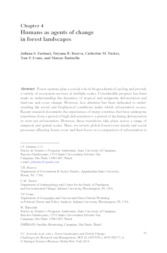Humans as agents of change in forest landscapes.
Humans as agents of change in forest landscapes.
Author(s): FARINACI, J. S.; RUSEVA, T. B.; TUCKER, C. M.; EVANS, T. P.; BATISTELLA, M.
Summary: Forest systems play a crucial role in biogeochemical cycling and provide a variety of ecosystem services at multiple scales. Considerable progress has been made in understanding the dynamics of tropical and temperate deforestation and land-use and cover change. However, less attention has been dedicated to understanding the social and biophysical conditions under which reforestation occurs. Recent research documents the experiences of many countries that have undergone transitions from a period of high deforestation to a period of declining deforestation or even net reforestation. However, these transitions take place across a range of temporal and spatial scales. Here, we review global forest-cover trends and social processes affecting forest cover and then focus on a comparison of reforestation in the states of São Paulo, Brazil, and Indiana, United States. Both states have undergone extensive deforestation but now show forest restoration alongside continuing deforestation. Our focus on forest change at the state level permits a detailed examination of deforestation and reforestation dynamics and of the diverse social factors that underlie these changes. Among these factors, human values and attitudes appear most important.
Publication year: 2014
Types of publication: Book sections
Unit: Embrapa Territorial
Observation
Some of Embrapa's publications are published as ePub files. To read them, use or download one of the following free software options to your computer or mobile device. Android: Google Play Books; IOS: iBooks; Windows and Linux: Calibre.
Access other publications
Access the Agricultural Research Database (BDPA) to consult Embrapa's full library collection and records.
Visit Embrapa Bookstore to purchase books and other publications sold by Embrapa.

